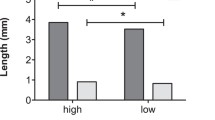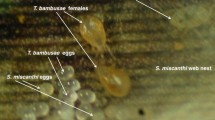Abstract
Female fecundity, oviposition preference and specificity on one normal and two novel food media were assayed on four laboratory populations ofDrosophila melanogaster, revealing considerable among- and within-population variation in oviposition preference. Overall, there was a significant tendency of females to prefer novel media to their normal banana food as an oviposition substrate. Specificity in the populations was fairly high, implying that a large proportion of females tended to lay the majority of their eggs on the preferred medium. The results showed that oviposition preference for a given food medium could be affected by the alternative provided, and that, consequently, oviposition preference for a given food medium versus another cannot be predicted based upon a knowledge of what the preference for each of the two media was versus a common third medium. Specificity, on the other hand, was not significantly affected by the type of alternative food media provided in a given trial. Moreover, comparison of results from fecundity and oviposition preference assays also showed that the egg laying behaviour ofDrosophila females in response to different food media may be different in choice versus no-choice situations. Thus, a substrate on which fecundity is higher than on another, when assayed in a no-choice situation, may not be preferred over the other substrate when a choice between the two is provided to the ovipositing females. The latter two results point to possible complexity in the responses of females to various oviposition substrates based upon the overall setting of the assay, including the alternative substrates present for egg laying.
Similar content being viewed by others
References
Barker J S F 1992 Genetic variation in cactophilicDrosophila for oviposition on natural yeast substrates;Evolution 46 1070–1083
Camara M D 1997 A recent host range expansion inJunonia coenia Huebner (Nymphalidae): oviposition preference, survival, growth and chemical defense;Evolution 51 873–884
Connor E F 1991 Colonization, survival and causes of mortality ofCameraria hamadryadella (Lepidoptera: Gracillariidae) on four species of host plants;Ecol. Entomol. 16 315–322
Fox A. W, Waddell K J and Mousseau T A 1994 Host-associated fitness variation in a seed beetle (Coleoptera: Bruchidae): evidence for local adaptation to a poor quality host;Oecologia 99 329–336
Freeman M F and Tukey J W 1950 Transformations related to the angular and the square root;Ann. Math. Stat. 21 607–611
Iwasa Y, Suzuki Y and Matsuda H 1984 Theory of oviposition strategy of parasitoids. I. Effect of mortality and limited egg number;Theor. Pop. Biol. 26 205–227
Jaenike J 1982 Environmental modification of oviposition behaviour inDrosophila;Am. Nat. 119 78–02
Jaenike J 1987 Genetics of ovipositionsite preference inDrosophila tripunctata;Heredity 59 363–369
Jaenike J 1989 Genetic population structure ofDrosophila tripunctata: patterns of variation and covariation of traits affecting resource use;Evolution 43 1467–1482
Jaenike J 1990 Host specialization in phytophagous insects;Annu. Rev. Ecol. Sysi. 21 243–272
Joshi A 1997 Laboratory studies of densitydependent selection: adaptations to crowding inDrosophila melanogaster;Curr. Sci. 72 555–562
Joshi A 1998 Evolutionary genetics of hostspecialisation in insects: an overview; inProceedings of the First National Symposium on Horticultural Pest Management (ed.) A Verghese (in press)
Joshi A and Mueller L D 1996 Densitydependent natural selection inDrosophila: tradeoffs between larval food acquisition and utilization;Evol. Ecol. 10 463–474
Joshi A, Oshiro W A, Shiotsugu J and Mueller L D 1997 Within and among-population variation in oviposition preference for ureasupplemented food inDrosophila melanogaster;J. Biosci. 22 325–338
Joshi A and Thompson J N 1995 Tradeoffs and the evolution of host specialization;Evol. Ecol. 9 82–92
Joshi A and Thompson J N 1997 Adaptation and specialization in a tworesource environment inDrosophila species;Evolution 51 846–855
Lederhouse R C, Ayres M P, Nitao J K and Scriber J M 1992 Differential use of lauraceous hosts by swallowtail butterflies,Papilio troilus andP. palamedes (Papilionidae);Oikos 63 244–252
Moreteau B, R’Kha S and David J R 1994 Genetics of a nonoptimal behaviour: oviposition preference ofDrosophila mauritiana for a toxic resource;Behav. Genet. 24 433–441
Mueller L D 1995 Adaptation and densitylependent natural selection; inGenetics of natural populations: the continuing importance of Theodosius Dobzhansky (ed.) L Levine (New York: Columbia University Press) pp 101–124
Rose M R, Nusbaum T J and Chippindale A K 1996 Laboratory evolution: the experimental wonderland and the Cheshire Cat syndrome; inAdaptation (eds) M R Rose and G V Lauder (San Diego: Academic Press) pp 221–241
Scriber J M, Giebink B L and Snider D 1991 Reciprocal latitudinal clines in oviposition behaviour ofPapilio glaucus andP. canadensis across the great Lakes hybrid zone: possible sexlinkage of oviposition preferences;Oecologia 87 360–368
Szentesi A and Jermy T 1990 The role of experience in host plant choice by phytophagous insects; inInsect-plant interactions (ed.) E A Bernays (Boca Raton: CRC Press) vol. 2, pp 39–74
Thompson J N 1988a Variation in preference and specificity in monophagous and oligophagous swallowtail butterflies;Evolution 42 118–128
Thompson J.N 1988b Evolutionary genetics of oviposition preference in swallowtail butterflies;Evolution 42 1223–1234
Thompson J N 1990 Coevolution and the evolutionary genetics of interactions among plants and insects and pathogens; inPests, pathogens, and plant communities (eds) J J Burdon and S R Leather (Oxford: Blackwell Scientific) pp 249–271
Thompson J N 1993 Preference hierarchies and the origin of geographic specialization in host use in swallowtail butterflies;Evolution 47 1585–1594
Thompson J N and Pellmyr O 1991 Evolution of oviposition behaviour and host preference in Lepidoptera;Annu. Rev. Entomol. 36 65–89
Thompson J N, Wehling W F and Podolsky R 1990 Evolutionary genetics of host use in swallowtail butterflies;Nature (London) 344 148–150
Wasserman S S and Futuyma D J 1981 Evolution of host plant utilization in laboratory populations of the southern cowpea weevil,Callosobruchus maculatus F. (Coleoptera: Bruchidae);Evolution 35 605–617
Wiklund C 1975 The evolutionary relationship between adult oviposition preferences and larval host plant range inPapilio machaon L;Oecologia 18 185–197
Wiklund C 1981 Generalist vs. specialist oviposition behaviour inPapilio machaon (Lepidoptera) and functional aspects on the hierarchy of oviposition preferences;Oikos 36 163–170
Author information
Authors and Affiliations
Corresponding author
Rights and permissions
About this article
Cite this article
Sheeba, V., Madhyastha, N.A.A. & Joshi, A. Oviposition preference for novel versus normal food resources in laboratory populations ofDrosophila melanogaster . J Biosci 23, 93–100 (1998). https://doi.org/10.1007/BF02703000
Received:
Revised:
Issue Date:
DOI: https://doi.org/10.1007/BF02703000




